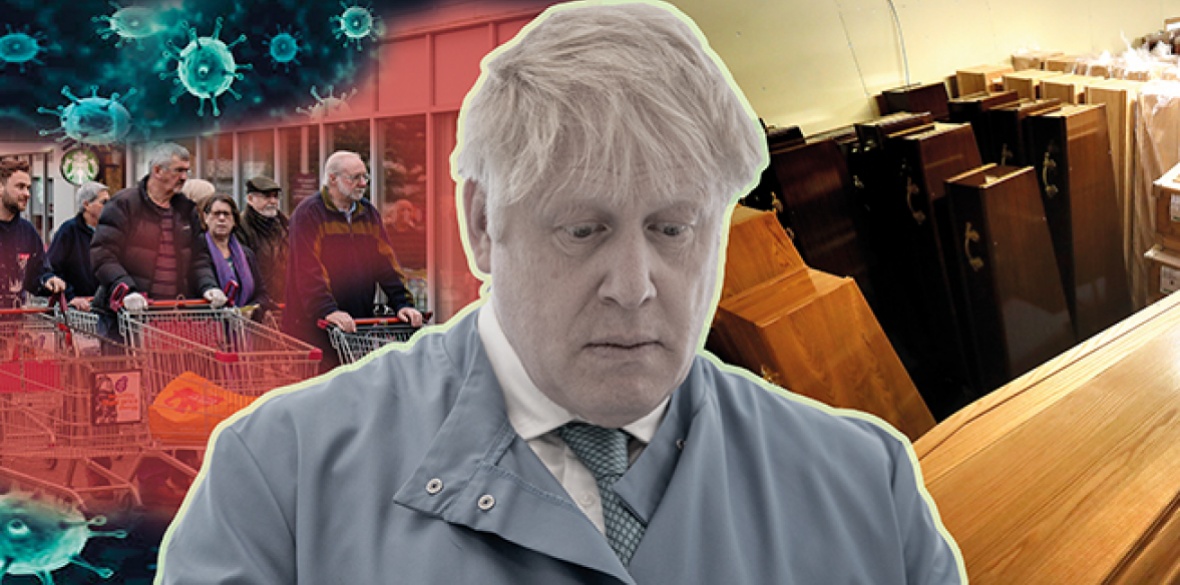This is the last article you can read this month
You can read more article this month
You can read more articles this month
Sorry your limit is up for this month
Reset on:
Please help support the Morning Star by subscribing here
TO MARK the one year anniversary of the first national lockdown last month, the Guardian published profiles of Chief Scientific Adviser Sir Patrick Vallance and Chief Medical Officer Chris Whitty.
“The wealthy civil servant’s year of speaking truth to power” was the title of the fawning article on Vallance. Discussing the early days of the pandemic, the Guardian’s Rupert Neate asserted “Vallance may have been one of the few people in Whitehall who understood what was coming.” Echoing the title, he noted “Vallance’s friends and colleagues say that he is not afraid to speak scientific truth to power.”
The profile on Whitty was similarly obsequious, titled: “The calm voice who steered a nation in crisis.” The co-authors Ian Sample and Heather Stewart wrote: “The crisis has demanded dedication and stamina, but Whitty has also needed the trust of those around him.”
There is a brief reference to mistakes made in the early days of the crisis, such as Whitty responding to Covid as if it was a flu pandemic, but overall the tone is deeply flattering. “Whitty’s calm authority appealed far beyond Westminster,” they note.
All of which makes the 2019 claim made by Guardian editor Katharine Viner that Guardian journalists “believe in holding the powerful to account” sounds rather hollow. More accurate is journalist Peter Oborne’s recent analysis in the Morning Star: “We have to understand that the British media class is an instrument of power and should be treated as such rather than a fourth estate holding power to account.”
Partly in response to the media’s poor performance at the beginning of the pandemic, since April 2020 Rupert Read and I have been compiling a detailed timeline of the government’s response to coronavirus. Updated and published every week since then and now totalling over 69,000 words, the timeline is made up of thousands of sources, including press reports, television and radio news, medical journals, health experts and organisations, trade unions and polling results.
Working with editor Joanna Booth, we have just published the timeline as a free eBook and pay-to-print book too — titled A Timeline Of The Plague Year: A Comprehensive Record of the UK Government’s Response to the Coronavirus Crisis.
So how does the Guardian’s stenography on Vallance and Whitty compare to the information found in our timeline?
For starters, the deadly concept of “herd immunity” is not mentioned in either of the two profiles. Herd immunity is when a large majority of the population are infected or vaccinated and therefore gain immunity and stop the spread of the virus.
In contrast, our timeline records that a senior politician told the Sunday Times he “had conversations with Chris Whitty at the end of January [2020] and they were absolutely focused on herd immunity.”
Vallance was even clearer about the government’s strategy on BBC’s Today programme on March 13 2020. One of “the key things we need to do” is to “build up some kind of herd immunity so more people are immune to this disease and we reduce the transmission,” he noted.
There are two huge problems with herd immunity — both widely understood in March 2020. First, the estimated mortality rates of the virus at the time — around 1 per cent, according to a Guardian report on March 7 2020 — would have meant around half a million deaths in Britain to achieve herd immunity. Second, there was “no clear evidence people who had suffered the virus would have lasting antibody protection” as the Sunday Times explained on May 24 2020.
Vallance and Whitty also made a series of catastrophic calls in the run-up to the first lockdown on March 23 2020. On March 9 2020 Vallance said holding “mass gatherings and so on — actually don’t make much difference.” Three days later he asserted “the peak may be something like 10 to 14 weeks away — it could be a bit longer.” The peak was actually under four weeks away, with 1,461 deaths recorded on April 8 2020.
Discussing restrictive measures, such as lockdown, to fight the virus at a Downing Street press conference, on March 9 2020 Whitty stated: “There is a risk if we go too early people will understandably get fatigued and it will be difficult to sustain this over time.”
Stephen Reicher, Professor of Social Psychology at the University of St Andrews and member of SPI-B (the group that provided behavioural science advice to government), later described Whitty’s analysis as “just plain wrong.”
Similarly, A BBC Newsnight investigation broadcast in July 2020 concluded there “doesn’t appear to have been much evidence… at the time” for Whitty’s claim that if lockdown was implemented too early people would get “fatigued.” Robert West, Professor of Health Psychology at University College London and member of SPI-B, commented: “This term ‘behavioural fatigue’… certainly didn’t come from SPI-B and it is not a behavioural science term. If you look in the literature you won’t find it because it doesn’t exist.”
The delay to lockdown was extremely costly. Backdated modelling by Oxford University estimates there were just 14,000 infected people in Britain on March 3 2020. By March 23 2020 the number was likely to have been 1.5 million.
“Those 20 days of government delay are the single most important reason why Britain has the second highest number of deaths from the coronavirus in the world,” the Sunday Times noted in May 2020. A December 2020 report by Imperial College estimated that imposing a national lockdown in just one week earlier in March 2020 would have saved 21,000 lives.
Moreover, we shouldn’t lose sight of the fact Vallance and Whitty have been at the centre of the government’s response to the crisis, which means they oversaw the decision to stop mass testing on March 12 2020, the ending of the quarantining of people arriving at British airports from coronavirus hotspots a day later, the thousands of deaths in care homes and the shambolic test-and-trace programme.
With over 150,000 people having died from Covid in Britain according to Office for National Statistics figures, the government’s response has been, as Lancet editor-in-chief Richard Horton noted, “a national scandal.”
None of this highly pertinent and damning information appeared in the two Guardian profiles.
In contrast, all of the information above can be found in our timeline, along with other key aspects of the crisis, including the mounting death toll, lockdowns, the Personal Protective Equipment shortage, the (lack of) border closures, the disastrous Eat Out To Help Out scheme, the dangers of Long Covid and support for a zero-Covid strategy.
We hope our comprehensive account of the “plague year” will be useful to anyone interested in understanding the government’s response to the crisis, historians studying the pandemic in the future and to the public inquiry that must be established.
“They really are scared that the verdict of history is going to condemn them for contributing to the deaths of tens of thousands of British citizens,” Horton commented about the British government in April 2020. “They are desperately trying to rewrite the timeline of what happened. And we must not let them do that.”
A Timeline Of The Plague Year: A Comprehensive Record of the UK Government’s Response to the Coronavirus Crisis by Ian Sinclair and Rupert Read is available as a free PDF, ebook and pay-to-print book from www.covidtheplagueyear.wordpress.com.
Follow Ian on Twitter @IanJSinclair.












